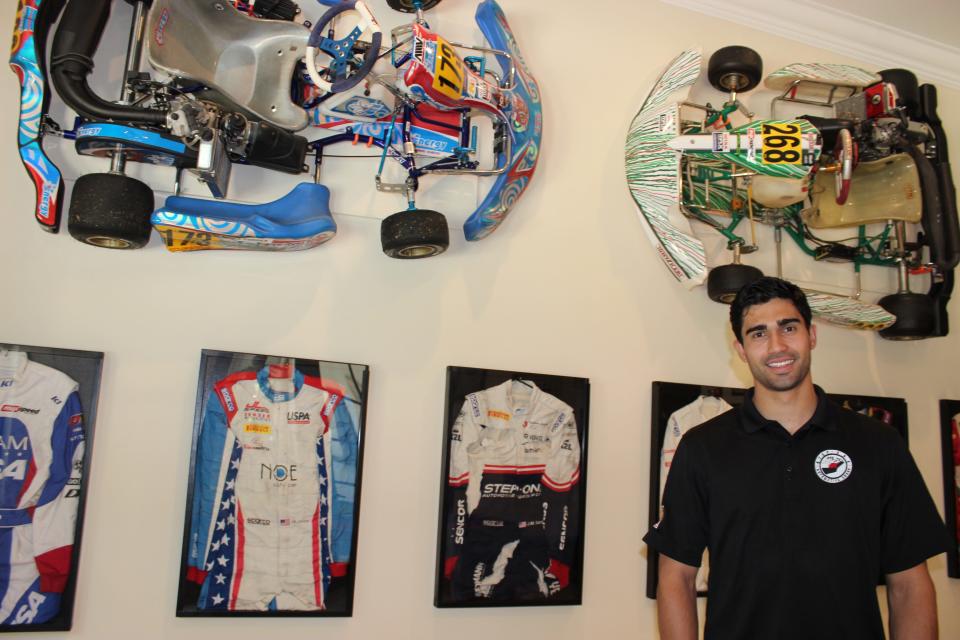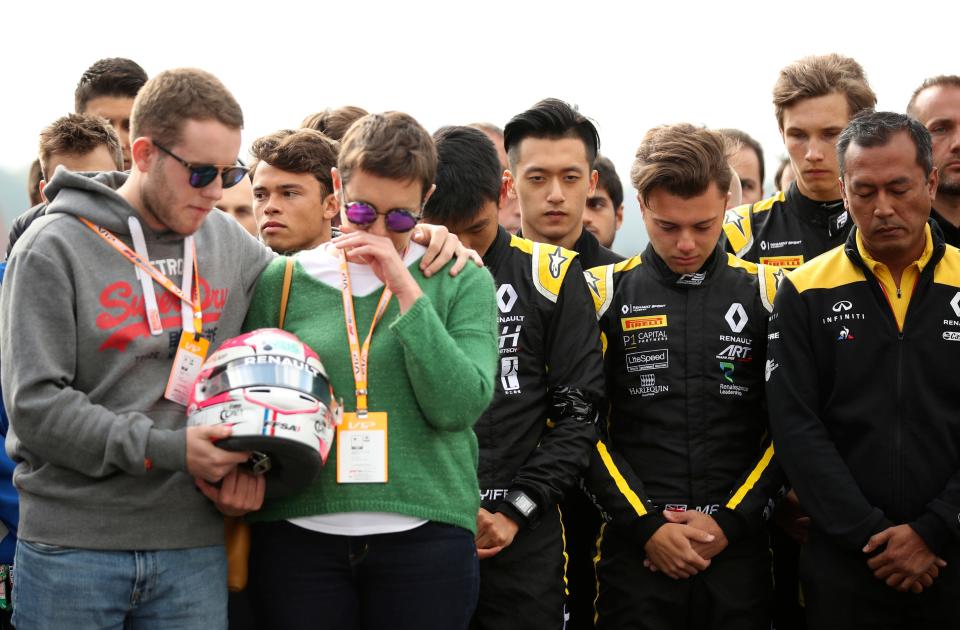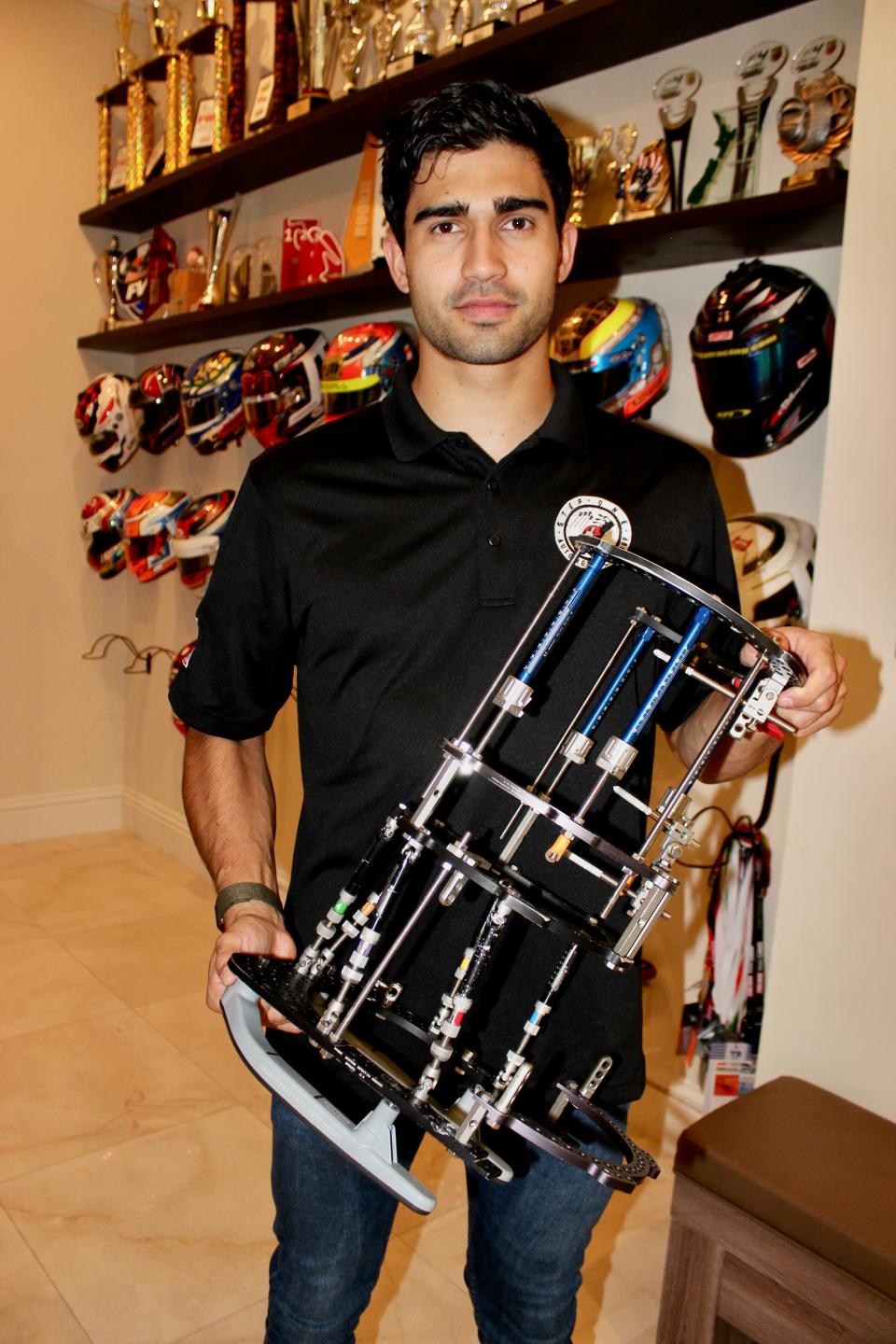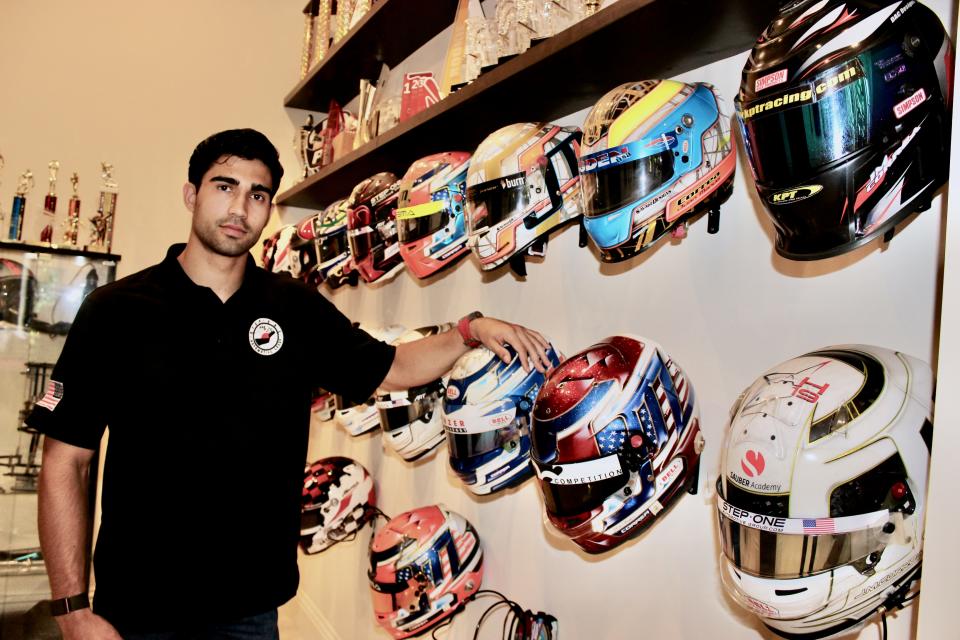Racing in hometown Miami Grand Prix is driver's dream after fatal crash, two dozen surgeries
PINECREST — But my start was good.
Juan Manuel Correa had just woken up from surgery, just woken up from a horrific crash at 135 mph, and the first thing that came to mind wasn’t how his race ended but how it began. Everyone in the hospital room in Belgium got a chuckle.
“Soon after, the humor kind of left the room,” Correa says.
It’s 3½ years later. Correa — friends call him “JM” — is back racing in Formula Two, as close as a driver can get to landing a spot in Formula One and competing in a Miami Grand Prix. Competing right up the road from where Correa began racing karts at age 7.
As big as the leap may be from F2 to F1, it pales compared to what these 3½ years have brought. Waking up in that hospital room? That was really the start.
Cuban Grand Prix and Fangio: ‘58 Cuban Grand Prix: Death, gangsters, a revolution and champion driver Fangio kidnapped
Lake Park man to the rescue: ‘The race that got lost': In 1960, Fidel Castro turns to Lake Park man to stage F1 event
Verstappen wins first Miami GP: F1's reigning champ takes inaugural Miami Grand Prix by a whisker
Surgeries? There were two dozen, one lasting 17 hours, the first couple requiring his family to weigh saving his right leg vs. saving his life. There were two weeks in a drug-induced coma. Rehabilitation that would have hurt like hell was even worse because he treated it like a race, accomplishing in months what they told him would take a year. All the while, knowing he still wanted to get behind the wheel but uncertain whether he’d regain the physical tools to do so.

Which doesn’t take into account another kind of pain that can never heal.
In the crash that Correa survived, another driver did not. His name was Anthoine Hubert. A Frenchman, just 22 years old. Only a month prior, Hubert and Correa ascended a podium together — on Hubert’s home track. It wasn't the first time they shared joy. It wasn’t uncommon to find them unwinding together following afternoon races in whatever part of the world the F2 tour took them to.

Knowing how hurt Correa would be over the loss of his friend, his family tried to keep the news from him. It helped that Hubert’s family and girlfriend made it clear that they didn’t blame Correa, that they were supporting him in his recovery. About five months after the accident, FIA, the sport’s governing body, released the results of an investigation that confirmed what Correa says he already knew: that he wasn’t at fault. That Hubert wasn’t at fault. That nobody was.
A loss of pressure in a tire on a car driven by Giuliano Alesi led to a chain of events difficult to watch, knowing how much destruction occurred in those 14.6 seconds. Two other numbers jump off the page in the report: 86 degrees, the angle at which Correa’s car T-boned Hubert’s after both of their cars were damaged in the four-car accident. The other number? 65 G's, the amount of force Correa experienced upon impact.
Crash serves as a reminder of risks F1 drivers must accept
To see a clip of the crash is to wonder how any driver survived. It’s also a reminder for anyone attending the Miami Grand Prix on Sunday that racing is safer than it once was. That does not mean it’s safe.
“If a single one of you watching and enjoying this sport think for a second what we do is safe you’re hugely mistaken,” seven-time world champion Lewis Hamilton wrote on Instagram as part of a tribute to Hubert. “All these drivers put their life on the line when they hit the track and people need to appreciate that in a serious way because it is not appreciated enough. Not from the fans nor some of the people actually working in the sport. Anthoine is a hero as far as I’m concerned, for taking the risk he did to chase his dreams.”
Whereas there were a dozen F1 deaths in the ‘70s, there have been only 11 since. What made Correa’s crash so spectacular — cars seemingly exploding on impact — actually makes the sport safer. Cars absorb impact to spare drivers.
“Unfortunately, my accident served as a warning, saying, ‘Hey, danger is still there. And it can come knocking at your door at any moment,'” Correa says.
Just because he knows that doesn’t make it easier to accept.
“One of the things I had to deal with as well, accepting that that had happened to me,” says Correa, who drives for the Van Amersfoort Racing team. “Like, what are the chances? There hasn’t been a fatality in motorsports in I think 20 years in Formula One and Formula Two. And now there is one and I am the second person involved in the crash and now in here in this hospital about to go into an induced coma. Like, it’s crazy.”
Correa has healed enough to watch the crash multiple times
Correa has watched a clip of the accident. Many times, in fact.
“I’m kind of numb to it, to be honest,” he says. “I guess, in my mind, I had to deal with the aftermath and the consequences of the crash with me, and what happened to me, and with my friend dying, for such a long time. But now when I look at it, I’ve kind of dealt with all of it. … That’s why I don’t mind sitting here and talking to you about it. Because it’s not something that triggers anything.”
If anything, “I think it’s healthy” to be able to talk about it, he adds.
So, what happened?
“I remember the whole thing, driving up the hill to this corner,” he says. “It’s a blind corner because it goes up a little crest. So you can see a piece of debris from the first car that crashed came sliding down, hit my car. My front wing went under my car. I lost control of the wheel. And all I remember was kind of looking up and seeing Anthoine’s car right in front of me.”
Correa is sitting in the “man cave” of the spacious home in which he grew up while attending Miami’s Palmer Trinity High. It’s a shrine to his racing career. On one wall are rows of his racing helmets, one more colorful than the next, plus dozens of trophies. On another wall are two of his karts and framed racing suits. But one suit is shorter than the others. It’s the one he was wearing in the crash. The one they had to cut apart to treat his legs.

In a corner of the room, in a glass-enclosed case, is the strangest memento. It’s an exoskeleton — essentially a halo he had to wear on his right leg that’s infinitely heavier than it appears. Its purpose was to help his healing tibia stretch by 10 centimeters over 100 days, or a millimeter a day. How? Four times a day, he had to turn the screws.
“You know the bone pain you get as a kid when you’re growing up, that aching of bone?” he says. “Yeah, it’s that multiplied by 50. Pretty brutal.”
Correa was introduced to racing by his father, Juan Carlos, who was in his mid-30s when he began racing rally cars and taking his son to the kart tracks.
“And I realized that’s what I wanted to do for the rest of my life,” JM says.
What he knew at age 7 he still knows at 23.
“Just really feeling like you’re fully in control of this, you know, 1,500-pound beast under you,” says Correa, who has two top-10 finishes in this year's four races. “It’s a very special feeling. And adrenaline is a drug. It is addictive. The pressure, the lifestyle of it, of always having something you’re looking forward to. There’s always that next race.”
Someday racing in Miami Grand Prix ‘would be my dream'
Correa has raced in beautiful, exotic locales, but last May, he attended a special event as a spectator. It was at Hard Rock Stadium, the inaugural Miami Grand Prix, which he calls “a very special event,” following years of little F1 action in the United States. He can’t attend this year’s race because of the F2 schedule but hopes the next Miami Grand Prix he attends is to race.
“It would be my dream,” he says. “That’s what I’m working towards, to be in the F1 grid in the next few years. And hopefully, next time you and I speak, it will not be for attending the Grand Prix, but because I’m about to drive in it. Yeah, that will be very special.”
It’s one thing to have that dream, and another to realize it. Correa is realistic.
“There’s only 20 F1 drivers in the whole world,” he says. “And there’s only 22 F2 drivers in the whole world. So that’s why it’s so competitive. And out of those 22 drivers in F2, we know that a few are going to go to F1.”
When Correa returned to racing, it was with a modified brake pedal. Today, he feels close to 100%, with only a slightly modified throttle pedal to offset limited mobility in his right ankle. Everything else, including his reflexes, are where they need to be, he says. Still, getting up in the morning can be a bear. Even after he loosens up, there are varying amounts of pain with every step.
“Changes I’ve learned to live with,” he says.
Legs ‘looked like puppet legs' as he dragged himself out of car
In many ways, he’s fortunate. Correa’s car, at one point airborne, came to rest upside down as a small fire broke out. Correa began dragging himself from the cockpit even though rescue teams were on the scene in seconds. He was in unspeakable pain, in shock, but alert enough to know his injuries were bad.
“My legs were like — they looked like puppet legs,” he says. “You know, like they were just hanging. Yeah, it was pretty grim.”
He immediately asked responders to sedate him. They did.
“I wanted to pass out from the pain, but I had so much adrenaline that I couldn’t pass out,” he says. “So I was just there. Like I couldn’t even breathe.”
His mother, Maria, desperately sought information in the paddock.
“I thought he was dead,” Juan Carlos says.
JM’s breathing problems were magnified in the coming days. After first operating on his left leg, doctors needed to perform more involved surgery to save his right leg. But his lungs were too weak to withstand it. What to do? Save his leg? Or his life?
“That was a whole debate all the time,” he says. “Like, ‘When do we go in on the legs? How much do we want to risk?’”
His parents released a statement that read, "Doctors are in a race against time to perform a pending major surgery in order to minimize risk of irreversible injuries to his right lower extremity but can't proceed until lungs are ready to withstand a lengthy operation."
The lone respite was in that moment he first awoke, a moment not unlike that of Buffalo Bills safety Damar Hamlin, who awakened days after going into cardiac arrest, then asked doctors whether his team won the game. In Correa's case, he pointed out how he'd started the race.
“So they were like a bit laughing at me, like, ‘How do you remember? You just had one of the worst accidents in the history of motorsports,’" he says. "The first thing I said was like, ‘Yeah, but my start was good, wasn’t it?’”
Correa risked his life to resume racing. The simpler way out would have been to lose his right leg, but that would have ended his career.
“That was really, for me, the deciding factor,” he says.
Today, he says if he had to advise someone in a similar position, he’d likely recommend amputation. For him, however, it was “the right decision.” He reaffirmed that the first time he climbed back in a car — on the same circuit in France in which Hubert won his homecoming race and Correa finished second. Since then, Correa has visited the track in Belgium where the accident occurred. Every year on the anniversary, he posts a tribute to Hubert on social media.
We miss you, mate. 💙 pic.twitter.com/peyItJ7KpE
— Juan Manuel Correa (@JMCorrea__) August 27, 2020
The accident has offered him perspective.
“I learned that I’m pretty strong,” he says. “Stronger than I thought I was. Mentally, I’ve learned that racing doesn’t really define me. And that I can be happy and live a fulfilling life even if racing wouldn’t be in the picture, which is something that I was not aware of before I had the accident.
“For me, racing was my life and it was either racing or nothing.”
Now?
“I do racing because I choose to.”
Reporter Hal Habib can be reached at hhabib@pbpost.com and followed on Twitter @gunnerhal.

Miami Grand PrixMiami International Autodrome, Hard Rock Stadium, Miami GardensFriday: First practice, 2:30 p.m., ESPN; second practice, 6 p.m., ESPNSaturday: Third practice, 12:30 p.m., ESPNSunday: Race, 3:30 p.m., ABC (coverage starts at 2 p.m.)Streaming options at Formula1.com
This article originally appeared on Palm Beach Post: Juan Manuel Correa, back from horrific crash, dreams of Miami Grand Prix

